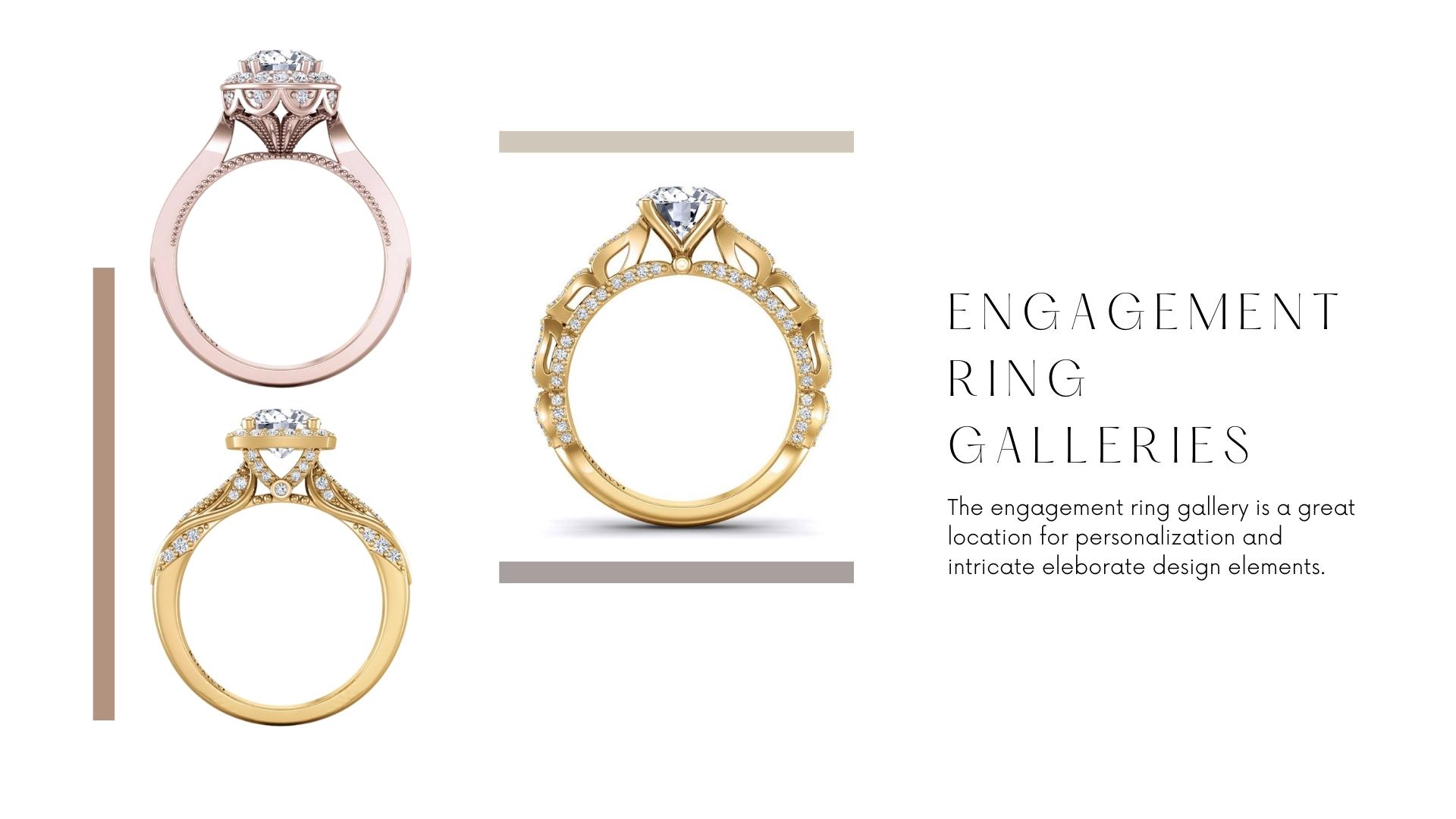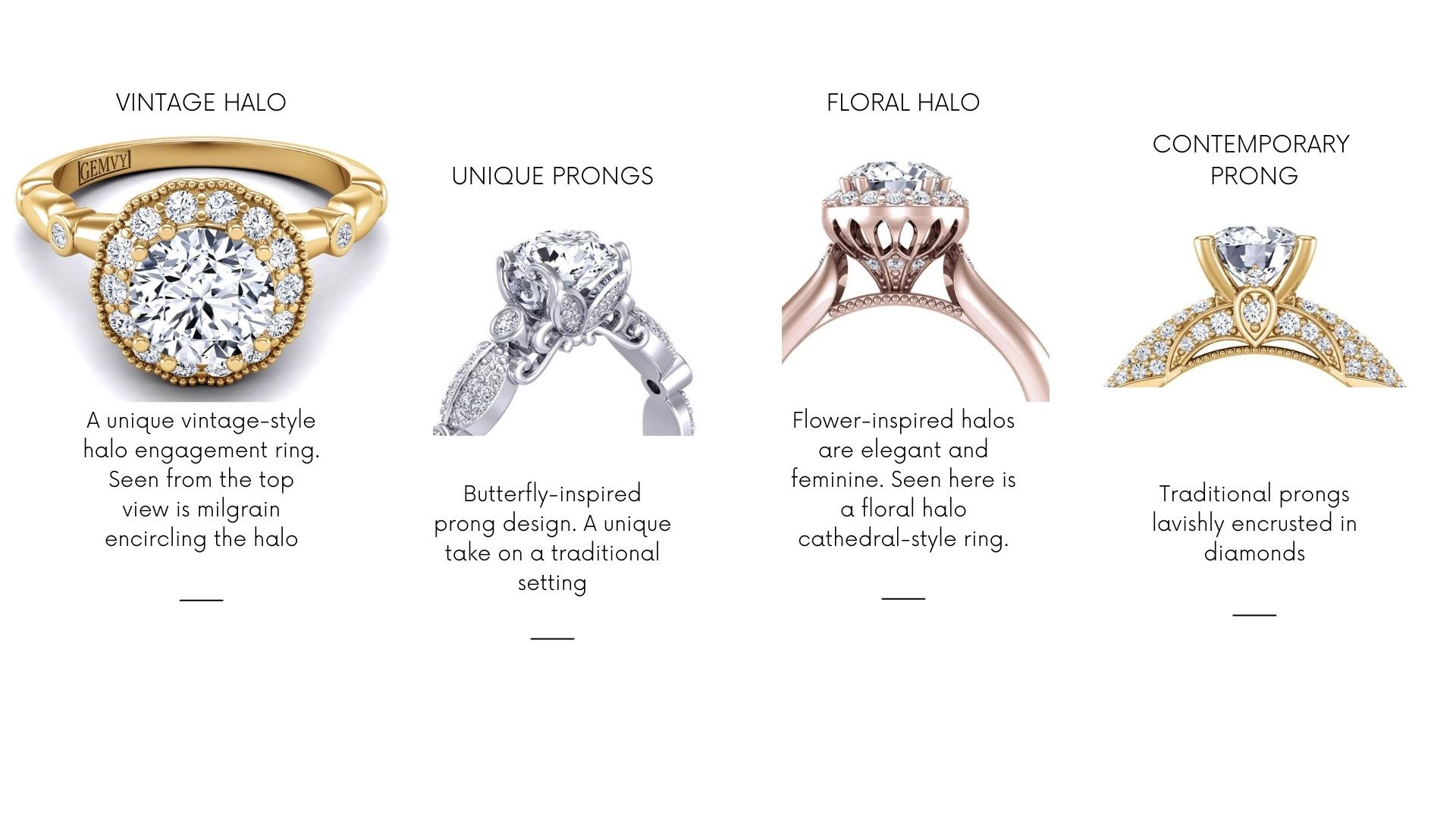Currency
CAD - Canadian Dollar

Are you looking for the perfect engagement ring for yourself or your significant other? We understand how stressful the process can be when searching for that statement engagement ring that isn’t just a piece of jewelry but has an in-depth significance of what you and your partner share. Finding such an engagement ring will require that you understand the entire parts and styles of a ring. We’ve taken the liberty to break down the complete styles and parts of an engagement ring for you. Read on to find out more.
Head or crown
The first thing you see when you get an engagement ring is its head. This is the area that holds the center stone in place, and it comes in different sizes and designs. Some ring heads are removable while others are part of the settings. Those fancy stones or motifs you see on the head of some rings are called a basket. While the basket may look like some fancy design, its main function is to provide stability and support for the center stone. 
Center stone
It will only be fair that we refer to the center stone as the star of the show because it tends to be the point of attraction of every engagement ring. If you doubt us, ask yourself this question: what do I see first when someone flaunts their engagement ring? Your answer was the stone, right?
The versatility of the center stones is why engagement rings cannot be boring. While the most common center stone is diamond- both mined and lab-created-, gemstones like sapphire, rubies, etc., are also perfect options for a center stone. However, what we love most is that you can choose or customize the center stone into any of the eleven available shapes which include round brilliance, Asscher, heart, pear, oval, cushion, radiant, emerald, marquise, princess, and trillion. Nevertheless, every shape has its unique characteristics and is not without pros and cons.
Halo Settings
The halo setting features smaller stones that surround the center stone, giving an illusion of a single large center stone. You can have single, double, or even triple halos, depending on your preference.
Bezel settings
The bezel setting (hyperlink) has a metal frame that surrounds the center stone for added stability and security but makes the stone appear smaller and reduces its brilliance because enough light cannot pass through it. The bezel setting is ideal for those who work a lot with their hands.
Prongs are part of the head and have a unique job of keeping the stone secure. They go from the bottom of the ring head to the top, holding the center stone from the sides.
The prong claws which secure the diamond are usually made from metals. An engagement ring with only prong settings mainly has a simple and minimalist look that not only makes the center stone the only point of focus but also allows a substantial amount of light to pass through it to show the stone’s brilliance. The various engagement ring prong styles include;
1. Pointed Claw prong
Prong settings are also called claw settings by jewelers. A claw prong has pointed tips, as well as elegant and sleek looks that give a simple and clean finish without covering a major part of the center stone.
2. Round prong
This is the most common type of prong style for engagement rings. The tips have round finishing that looks like tiny dots on the sides of the diamond, blending seamlessly into the diamond while firmly securing it in place.
3. V-tipped prong
As the name implies, the v-tipped prongs have v-shaped tips that protect the pointed corners of fancy diamond cuts like marquise, pear, oval, heart, etc., preventing them from chipping.
4. Flat tab prong
This is not as popular as the round or claw prong settings. Its flat tip and surface have a lower profile that prevents it from snagging or latching onto things.
5. Double claw prong
Double claw prongs can either have rounded or pointed tips to secure a large diamond firmly. This prong style is quite stylish but looks better when the same amount of metal that should have been used for a single prong is used for two to create an illusion of thinner prongs.
6. Four prongs
Four prongs make the diamond more visible and allow light to pass through it easily. For extra security, four prongs are usually ideal for smaller or medium-sized diamonds or gemstones.
7. Six prongs
Large diamonds need extra firmness to secure them in place and six-prong style provides this security.
8. Heart prongs
Whatever cut, whatever shape of the diamond, the heart prong securely holds it down and gives it a romantic appearance.
9. Fist tail prongs
Fishtail prongs are common with antique or vintage engagement rings with round brilliance diamonds. Their unique shape gives the illusion of a square shape and a larger center stone.
10. Shared prongs
Shared prongs economize space on the rings so that melee stones or smaller-sized diamonds are placed with the same amount of metal to avoid distraction from the sparkle and overwhelming the appearance of the ring.
11. Tulip prongs
Although tulip prongs secure the diamond in place with more metals than other prong styles, thus reducing the amount of light that passes through it, they have a classic style and provide more stability for the diamond.
When you look at the side profile of a ring just beneath the head, the area that you can see is called the gallery. Some are plain with a minimalist look while others have fancy and intricate designs with just metals or stones inclusive. While the gallery may seem like just some accentual addition to the ring, it adds extra stability to the prongs in securing the center stone in place.
The under part of the gallery that connects the head or setting to the shank is called the bridge. This is the part that sits on the top of your finger, holding up the settings for utmost visibility. The bridge can be plain or feature small stones to add style to the ring.
The shoulders are the two sides of the ring that connects the head to the shank. It usually has a straight or curved design and may also have accent stones, depending on the style of the ring.
 Engagement Ring Shanks
Engagement Ring ShanksThe shank is what you know as the hoop or band of the ring. It is the part of the ring that wraps around your finger and is made from various metals- gold, silver, platinum, etc., and comes in different engagement ring shank styles and designs, which we will discuss below.
I. Straight shank
A straight shank has a simple construction with a flat edge, no split, and no taper. This shank style naturally and easily fit into the finger, which is why it is called the ‘comfort fit’. The straight shank works perfectly for solitaire settings like in the case of this custom solitaire 4-prong engagement ring.
II. Split shank
When you look at a split shank from the top, it gives the illusion of two bands but it is a single shank that splits into two as it comes close to the center stone. The split shank can be modified into different designs according to the client’s preference. An example is this Swan-inspired split shank pave from Gemvy.
III. Tapered shank
A tapered shank or band has different widths at different points because it becomes thinner as it reaches the center stone or setting. This engagement ring shank style is popular among brides because it makes the center stone look larger than it is and gives the illusion of a long finger.

The sharp edge of this shank runs around the outer edge where it splits into two and has slanted sides that make it look like a knife. Don’t worry; the edge is not razor sharp! Nonetheless, it gives the band a unique and complex design like thisknife-edge pave set halo engagement ring.
V. Bypass shank
A bypass shank has one of its ends curved around the top of the stone and the other on the bottom. The two ends of the band or shank do not align instead, they wrap around the stone in a twisted manner that looks like they are bypassing it.
VI. Interlocked shank
This shank type has a stackable design that compliments each other and perfectly interlocks together. This design creates the ideal situation to wear the engagement and wedding rings together. The interlocking design can be created to sit perfectly on each other, intertwine, or in any creative way that seems to make sense to both the client and jeweler.
VII. Cathedral shank
The cathedral shank has two frame arches lifted on both sides making it look as though it is lifting the center stone. When viewed from above, it gives the unique architectural look of a cathedral, hence the name.
VIII. Channel settings
Smaller diamonds or other gemstones are arranged in a row on the metal walls of the shank of the ring without beads or prongs separating them. Channel settings can be entirely made of smaller stones or have a centre stone like this princess channel set ring PR-1470-J.
1. Solitaire settings
The solitaire setting is the most common and classic mounting style among brides and jewelers. It has a single diamond of any cut and no diamond on the band.
2. Three-stone settings
Two stones of the same size are placed beside a center stone, signifying the past, present, and future of your relationship. It isn’t compulsory to use diamonds as the side stones as there are other gemstone options as well.
3. Pave settings
The word comes from a French word, which means “to pave”. Small diamonds called ‘melees’ are closely arranged together on the ring band and are held by tiny prongs or beads that are barely visible.
An antique or vintage engagement ring is inspired by engagement ring designs from past eras such as the Edwardian, Victorian, or Art Deco times. Although some vintage engagement rings are real antiques from at least 50 years ago, jewelers have shown their skillfulness in recent times, replication some of these timeless pieces to suit their customers' preferences.

Milgrain embellishments are tiny dots of metals used to create unique details along the edge of the band. For example,this Art Deco-inspired ring from Gemvy features Milgrain on the gallery view.
II. Filigree explained
Most Vintage engagement rings are known for their delicate and classic metalwork with twisted metal threads or metal beads known as filigree. The vintage style rollover halo engagement ring heir-1129-c is a good example and shows elegant filigree lining the sides of the shank.
III. Vintage Engraving
Vintage engagement rings often feature various decorative designs like floral motifs, monograms, and other antique style patterns, carved into the metal.
In conclusion, knowing the anatomy of an engagement ring makes it easy to select or creates the ideal engagement or wedding ring according to your preference. One can never be too carefree when it comes to engagement rings because of the memories surrounding the moments they create, as well as the significance it carries. So, reach out to us at Gemvy, let’s help you find the ideal engagement ring to create unforgettable memories.
Leave a Reply